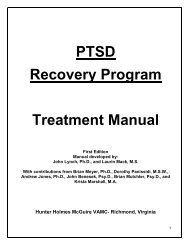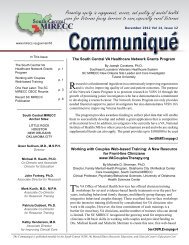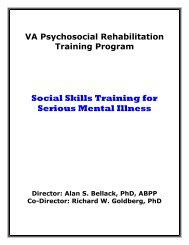Suicide Risk Assessment Package (VISN 3 MIRECC, US ...
Suicide Risk Assessment Package (VISN 3 MIRECC, US ...
Suicide Risk Assessment Package (VISN 3 MIRECC, US ...
Create successful ePaper yourself
Turn your PDF publications into a flip-book with our unique Google optimized e-Paper software.
This document may be used only with the permission of the <strong>VISN</strong> 3 <strong>Suicide</strong> Workgroup<br />
and the <strong>VISN</strong> 3 <strong>MIRECC</strong><br />
Mitigating Factors: (alternatives to suicide, plans and hopes for future, beliefs<br />
supportive of continued living, religious beliefs, reasons to continue living, dependant<br />
children, psychic toughness, other)<br />
Describe: free text required<br />
These are all the factors that diminish the risk of patients acting on suicidal feelings or<br />
impulses, or of reaching the level of suicidal behavior in the face of high risk symptoms,<br />
diagnoses, and circumstances. None are absolute and must be judged against the<br />
circumstances contributing to risk. Included in mitigating factors are good relationship<br />
with caregiver, a good therapeutic alliance, intact social supports, problem solving and<br />
coping skills, and awareness that suicide is a product of an illness (2,4,5)<br />
Psychic Toughness is best defined as the demonstrated lifelong resiliency to pain,<br />
stress, discomfort and the problems of life. It refers to those who can take the<br />
difficulties, usually manage them and continue functioning. It also refers to the capacity<br />
to endure distressing experiences and circumstances, as well as the quantity of intense<br />
affect a person can bear. This resiliency is both a general capacity for enduring and<br />
bearing pain and tumult, but can also be specific. An individual may have a high<br />
capacity for certain types of distress and a lower threshold for others.<br />
Category of <strong>Risk</strong>: (the first check off is if there are acute factors, identified above,<br />
currently active that need to be addressed)<br />
[ ] Acute Factors Current<br />
(the next two categories refer predominantly to the long-term or diathesis type risk,<br />
rather than aspects of more acute suicide risk)<br />
[ ] Baseline Increased <strong>Risk</strong><br />
[ ] Limited risk<br />
There is no fixed formula for determining the level of suicide risk and this evaluation<br />
requires good clinical judgment. Generally it is related to the level of pain the individual<br />
is in, that individual’s ability to bear the pain, while finding ways to solve or endure the<br />
problems (symptoms and circumstances) leading to the current state, without attempting<br />
to end the pain by ending one’s life. Like physical pain, psychic pain does not follow a<br />
pure lesion model; symptoms and stressors that are unendurable for one patient may be<br />
quite endurable for another.<br />
Roughly the level of suicide risk is proportional to the amount of distress from the<br />
patients psychiatric symptoms and distress from environmental, psychological and social<br />
stressors, and inversely proportional to the ability to endure those stressors, and the<br />
mitigating factors.<br />
This is the stress aspect. The diathesis is the factors that make it less likely that the<br />
person will be able to endure the stressors of life. These are the risk factors of the<br />
psychiatric illnesses listed above, the trait of aggressive impulsivity and behaviors<br />
associated with this, a history of previous suicide attempts, and a family history of<br />
suicide.<br />
The diathesis factors are relatively immutable and are facts of the patients’ life. A<br />
psychiatric diagnosis plus any of the other factors places a patient in a chronic high risk<br />
category. The psychiatric diagnosis itself, particularly if the patient remains<br />
symptomatic, or if any acute factors are present, may be enough for a clinician to make<br />
the judgment that a patient is a chronic high risk. It is important to note that the<br />
psychiatric diagnosis, despite being a longstanding issue is mutable; adequate treatment<br />
may place the illness in complete remission. For a patient in complete remission of their<br />
psychiatric syndrome, it can be appropriate to lower their chronic risk level. Such a<br />
remission frequently strengthens the patient’s therapeutic alliance, hopefulness, and of<br />
course, diminishes their psychic pain.<br />
The assessment has two tasks. The first is to help in identifying those patients who are<br />
chronic high risk individuals. The second is to help identify those individuals developing






